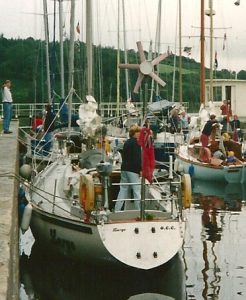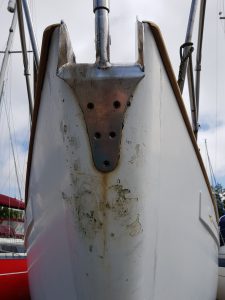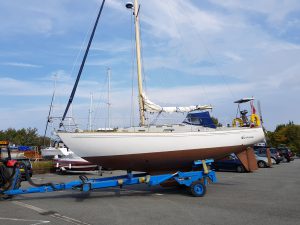June 19th 2018
This is me being philosophical.
Five days into a passage from Suffolk to the Outer Hebrides (which is about as far as you can go without leaving the country) and I am off the North East corner of Scotland, have been listening to gale warnings for the past 48 hours and the Navtex machine has just spewed out the following information: “Sea area Cromarty gale now ceased.”
I could have told them that. If I poke my head out of the hatch, my hat does not get blown off. Not to put too fine a point on it, there is no wind at all. None. We are going nowhere.
I woke from my afternoon nap (to differentiate it from my morning nap, my evening nap and my various night-time naps) to the sound of sails slatting from side to side, the boom banging and the self-steering clonking.
This is what happens when the wind suddenly stops. One minute it is blowing a “strong wind” as the meteorologists would have it – and the next you have a calm (I looked it up. “Sea state: Calm, glassy, like a mirror.” This was not even Force One which is “Ripples like scales are formed.”
This is when the Old Man must stop thinking about progress. After all this is not a race. I have no-one to measure myself against. So, a distraction is what is needed. There are two distractions on this boat. One is Mr Kipling’s Cherry Bakewell Tarts and the other is Mr Kipling’s French Fancies.
If you’re not familiar with British supermarket shelves, Mr Kipling is baker. He has a little corner shop just off the High Street where he produces the most wondrous cakes and pastries – a sort of Willie Wonka of the bakery world. As often as not, he will pop an extra macaroon into your paper bag with a conspiratorial wink as if to say: “Don’t tell Mrs Kipling”.
At least that is the image behind the brand dreamed up by the advertising agency employed many years ago by the vast conglomerate (Kraft? Unilever?) which owns the Mr Kipling brand.
Anyway, I was in Sainsbury’s doing the last-minute victualling (serious stuff like corned beef and porridge oats) when I couldn’t help noticing that Mr Kipling’s Cherry Bakewell Tarts and his French Fancies were on Special Offer – and we do love a special offer.
So far, so good. The colourful boxes were stowed away with everything else – at least, the Cherry Bakewell Tarts were – what happened to the French Fancies, I have not the faintest idea.
To coin a line from Titanic: “There are only so many places they can be. Find them Lovejoy. Find them…”
Normally, this wouldn’t be a problem. They would turn up. But a calm does funny things to the mind. Suddenly a French Fancy was the only thing that would do. Previous love affairs with Cherry Bakewell Tarts were forgotten in the frantic search – digestives cast aside – Tunnock’s Caramel Wafers chucked in with the cook-in sauces. Packets and packets of Penguin biscuits (why so many) ended up in with the rusty chopped tomatoes…
There was a moment when I sat back on my haunches in the middle of the not-very-large cabin, surrounded by packets and tins and jars and came to my senses. The logic went like this: The French Fancies were here. It was just that I couldn’t see them – like looking for the butter in the fridge (I’m looking for butter in a gold wrapper. How am I supposed to see butter in a plain wrapper).
So here was the deal: I would make a cup of tea and have one of Mr Kipling’s Cherry Bakewell tarts. Only after that would I put everything away – and if, in the course of restoring order, I happened to chance on the French Fancies, well… I could reward myself with one of those as well – and another cup of tea.
And do you think I found them? Of course I found them. Right next to the Cherry Bakewell Tarts – only they were in a slightly smaller colourful box (Fancies are smaller than Tarts – it makes sense). I was looking for a box the same size.
I had hardly finished the last mouthful, carefully collecting the crumbs by squashing them with my finger (I must be watchful for deteriorating personal habits) when I realised that the whole world had leaned over a bit and there was a delightful chuckling sound as the water started moving past the hull.
We were on our way once again.




